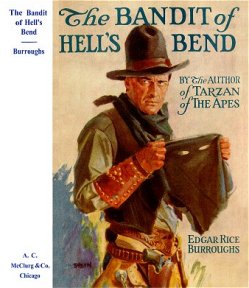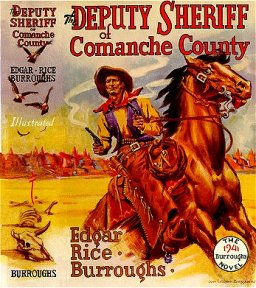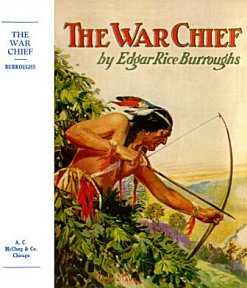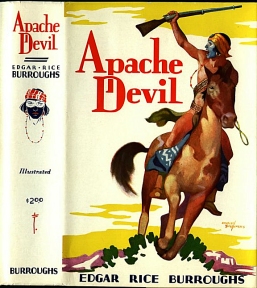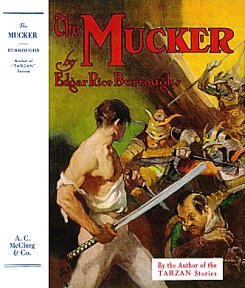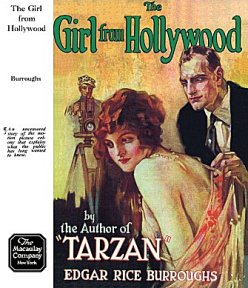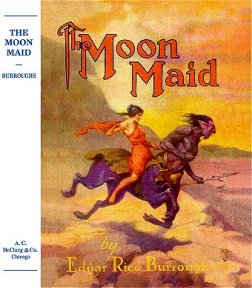Edgar Rice Burroughs -- the the pubic at large,
this name probably conjures up the name, and many cinematic images, of
his best-known literary creation, Tarzan of the Apes.
To those of us who grew up on and with him, his name
conjures up a whole lot more. Many worlds more, in fact. The worlds of
Barsoom (Mars), Amtor (Venus), Pellucidar, Opar, Laythe, Caspak, Pnom Dek,
and Lodidhapura, to name but a few.
Edgar Rice Burroughs ("ERB") had a vivid imagination
and a great and rare talent for giving life, with words, to those many
worlds.
ERB was able to combine that vivid imagination, his
great gift as a writer, and his actual, real-life experiences in
the West, to capture the American West in what I think are four of the
best adventure novels ever to flow from his pen.
Those four novels are: The War Chief; its sequel,
Apache Devil; The Bandit of Hell's Bend; and The Deputy Sheriff
of Comanche County.
All four novels take place in the great American Southwest.
More specifically, all four take place almost entirely in the state of
Arizona, where ERB once served (very briefly), if I'm not mistaken, with
the Seventh Cavalry. He thus knew, first-hand, the area that he wrote about.
There, and in his days in Idaho as a prospector with
his brothers, he met and knew many of the people whom he might have used
as prototypes for the characters who later peopled his novels: as the characters
and for the habits and characteristics of his characters.
What picture(s) do we get of the West, and of its characters,
from a reading of ERB's four Western novels?
As I see it, he gives us a land that is huge, awe-inspiring
-- a land of hidden wealth: gold, silver and oil being the three best known
and most valuable. A land unyielding of those resources and of the wealth
they represent; yielding this wealth only to the most determined people
-- the lucky ones. A land that would become the home of great farms and
ranches -- and again yielding a living only to the hardiest and most stubborn/determined
ranchers and farmers.
The heroes and heroines of ERB's Westerns are hard-working,
determined men and women -- men and women who don't hesitate to work for
what they want or to fight to defend what they have, and for the "Right"
as they see it; men and women who know right from wrong -- who don't push
other people around and who won't allow anyone else to ever push them around.
Another interesting theme in each of ERB's four Westerns
is the idea that things aren't always what they seem to be. This is especially
true regarding who and what we think people are, as distinct from
what they really are.
The War Chief begins with the baby Andy McDuff
orphaned by Geronimo and his band of warriors. To them, he is just another
white baby -- but they have no way of knowing that his mother was one-quarter
Cherokee.
Conversely, when Wichita Billings tries to fight falling
in love with an Apache, she has no way of knowing that his biological parents
were white.
In Deputy Sheriff, Bruce Marvel appears to be
a milk-fed Eastern dude and is derided for it by all around him. But when
the proverbial chips are down, he eventually shows them all just who and
what he really is -- and the stern stuff that he is really made of; that
he is, in reality, Buck Mason, the Deputy Sheriff of Comanche County.
The same holds true in The Bandit of Hell's Bend.
Not until nearly the end do we learn who the bandit of Hell's Bend
really is -- and conversely that he is not, and never really was, the man
whom almost everyone was ready to believe he was -- and was equally ready
to hang.
Please not that I have not made any mention of ERB's
novel The Mucker. I've neglected it for two reasons.
First, because very, very little of it takes place
in the West, and second, that part takes place almost entirely in Mexico,
on the ranch owned by the Hardings.
I'm not trying to denigrate The Mucker. It is
a good yarn. I just did not think that it had any real place in this discussion.
I enjoyed reading Burroughs' four western novels. To
me, they represent his writing talents and his imagination at their best.


